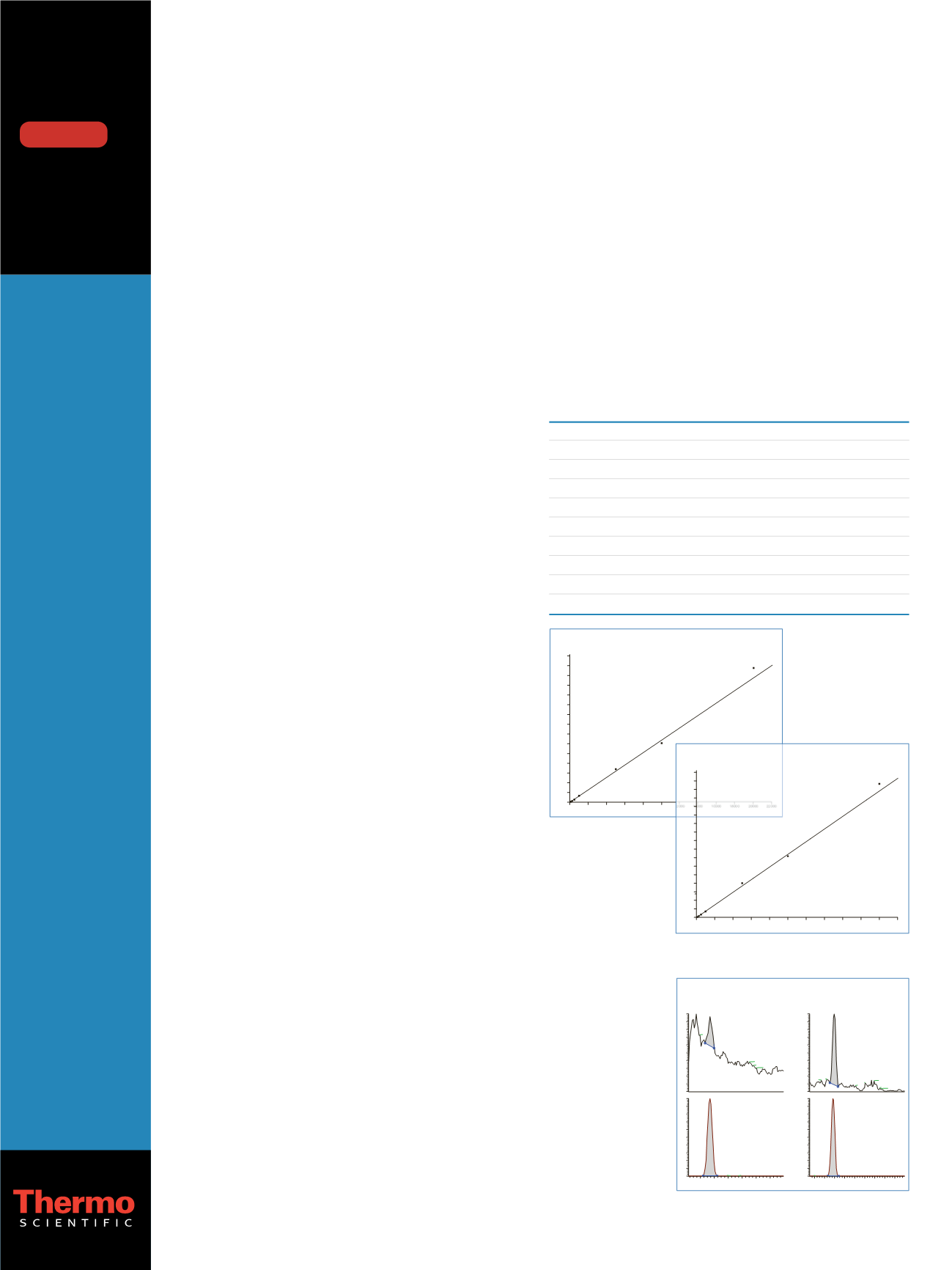

Quantitation of Urinary Ethyl Glucuronide
and Ethyl Sulfate Using Ultrahigh Resolution
LC-MS
Forensic Toxicology Use Only
Kent Johnson, Fortes Laboratories, Portland, OR; Marta Kozak, Thermo Fisher Scientific, San Jose, CA
Introduction
Ethyl glucuronide (EtG) and ethyl sulfate (EtS) are
sensitive and specific urinary biomarkers of recent alcohol
intake that are of great interest in today’s forensic
toxicology laboratories.
Goal
To demonstrate the quantitation of EtG and EtS in urine
using a liquid chromatography-mass spectrometry
(LC-MS) method with ultrahigh resolution on the Thermo
Scientific Exactive benchtop mass spectrometer.
Experimental
Calibration Standards and Sample Preparation
Calibration standards were prepared by spiking blank
urine with EtG and EtS to final concentrations ranging
from 25 ng/mL to 20,000 ng/mL.
Calibration standards and urine samples were spiked
with internal standards (EtG-d5 and EtS-d5) and diluted
10 times with an LC mobile phase prior to injection onto
the analytical column.
Commercial QC samples were used to obtain method
accuracy and precision.
HPLC
HPLC analysis was performed using a Thermo Scientific
Accela liquid chromatography system with a Thermo
Scientific Hypersil GOLD C18 column (50 x 2.1 mm;
5 µm). A diluted sample of 20 µL was analyzed with a
6-minute gradient method.
Mass Spectrometry
MS analysis was carried out on the Exactive™ benchtop
LC-MS instrument equipped with an electrospray
ionization (ESI) source. Full scan data with resolution of
100,000 FWHM at
m/z
200 was acquired.
Results and Discussion
Figure 1 shows the linear calibration curves for EtG
(100-20,000 ng/mL) and EtS (100-20,000 ng/mL).
Figure 2 shows chromatograms of EtG and EtS at
25 ng/mL and the respective deuterated internal standards.
Chromatograms for compound detection and quantitation
are reconstructed with a mass tolerance of 5 ppm.
Conclusion
The Exactive benchtop LC-MS instrument provides
excellent quantitative analysis of EtG and EtS in a
6-minute method. When applied to real samples, the
method meets the demands of today’s forensic toxicology
laboratories with exceptional performance.
Method Performance Summary
Target Analytes
Ethyl glucuronide
Ethyl sulfate
enirU
enirU
xirtaM
LOD
25 ng/mL
25 ng/mL or less
LOQ
100 ng/mL
100 ng/mL
Recovery
> 85%
> 85%
Precision
< 15%
< 15%
Assay Linearity
100 – 20,000 ng/mL
100 – 20,000 ng/mL
%1 <
%1 <
QOLL ta revoyrraC
Sample Volume
100 µL
100 µL
Analysis Time
6 minutes
6 minutes
Key Words
• Exactive
• Accela HPLC
• EtG / EtS
• Pain
Management
• Forensic
Toxicology
Application
Note: 488b
1.8
2.0
2.2
2.4
2.6
2.8
Time (min)
0
10
20
30
40
50
60
70
80
90
100
0
10
20
30
40
50
60
70
80
90
100
RelativeAbundance
RT:1.94
MA:10638
1.74
1.80
2.13
2.48
2.35
2.50
2.56
2.88
2.61
RT:1.94
MA:611241
2.29 2.35
2.63
2.23
2.81
2.2 2.4 2.6 2.8 3.0 3.2 3.4 3.6 3.8
Time (min)
0
10
20
30
40
50
60
70
80
90
100
0
10
20
30
40
50
60
70
80
90
100
RelativeAbundance
RT:2.59
MA:19113
2.45
3.33
2.33
3.39
2.74
3.21
2.91 3.01
3.50 3.53 3.86
RT:2.56
MA:756109
2.96
2.77
12.2
33.2
3.44
25 ng/mL standards (LOD)
StE
GtE
EtG-D5
EtS-D5
Figure 2: LOD chromatograms of EtG and EtS at
25 ng/mL with deuterated internal standards.
0
2000
4000
6000
8000 10000 12000 14000 16000 18000 20000 22000
ng/mL
0
2
4
6
8
10
12
14
16
18
20
22
24
26
28
30
AreaRatio
EtG 100- 20,000 ng/mL
EtS 100-20,000 ng/mL
0
2000
4000
6000
8000 10000 12000 14000 16000 18000 20000 22000
ng/mL
0
2
4
6
8
10
12
14
16
18
20
22
24
26
28
30
32
34
AreaRatio
Figure 1: Linear calibration curves for EtG (100-20,000 ng/mL) and EtS
(100-20,000 ng/mL).
DOWNLOAD


















